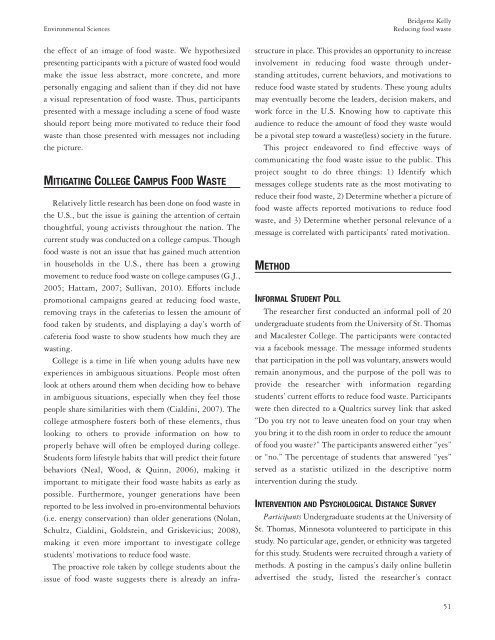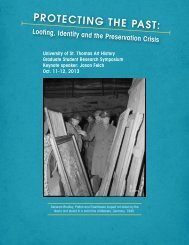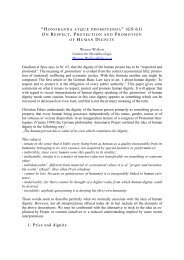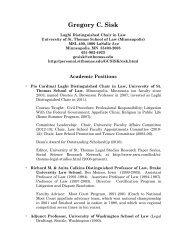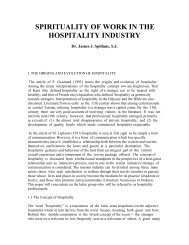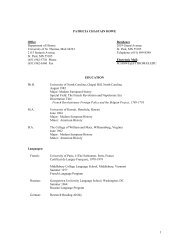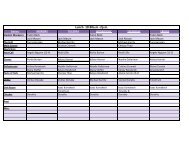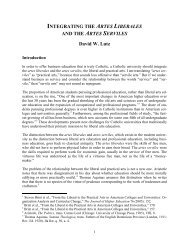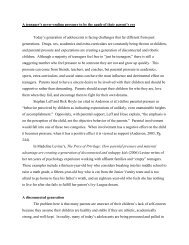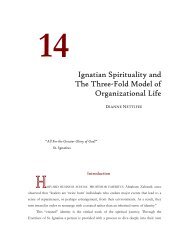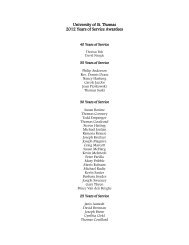dr. ronald e. mcnair acknowledgements - University of St. Thomas
dr. ronald e. mcnair acknowledgements - University of St. Thomas
dr. ronald e. mcnair acknowledgements - University of St. Thomas
You also want an ePaper? Increase the reach of your titles
YUMPU automatically turns print PDFs into web optimized ePapers that Google loves.
Bridgette Kelly<br />
Environmental Sciences Reducing food waste<br />
the effect <strong>of</strong> an image <strong>of</strong> food waste. We hypothesized<br />
presenting participants with a picture <strong>of</strong> wasted food would<br />
make the issue less abstract, more concrete, and more<br />
personally engaging and salient than if they did not have<br />
a visual representation <strong>of</strong> food waste. Thus, participants<br />
presented with a message including a scene <strong>of</strong> food waste<br />
should report being more motivated to reduce their food<br />
waste than those presented with messages not including<br />
the picture.<br />
MITIGATING COLLEGE CAMPUS FOOD WASTE<br />
Relatively little research has been done on food waste in<br />
the U.S., but the issue is gaining the attention <strong>of</strong> certain<br />
thoughtful, young activists throughout the nation. The<br />
current study was conducted on a college campus. Though<br />
food waste is not an issue that has gained much attention<br />
in households in the U.S., there has been a growing<br />
movement to reduce food waste on college campuses (G.J.,<br />
2005; Hattam, 2007; Sullivan, 2010). Efforts include<br />
promotional campaigns geared at reducing food waste,<br />
removing trays in the cafeterias to lessen the amount <strong>of</strong><br />
food taken by students, and displaying a day’s worth <strong>of</strong><br />
cafeteria food waste to show students how much they are<br />
wasting.<br />
College is a time in life when young adults have new<br />
experiences in ambiguous situations. People most <strong>of</strong>ten<br />
look at others around them when deciding how to behave<br />
in ambiguous situations, especially when they feel those<br />
people share similarities with them (Cialdini, 2007). The<br />
college atmosphere fosters both <strong>of</strong> these elements, thus<br />
looking to others to provide information on how to<br />
properly behave will <strong>of</strong>ten be employed during college.<br />
<strong>St</strong>udents form lifestyle habits that will predict their future<br />
behaviors (Neal, Wood, & Quinn, 2006), making it<br />
important to mitigate their food waste habits as early as<br />
possible. Furthermore, younger generations have been<br />
reported to be less involved in pro-environmental behaviors<br />
(i.e. energy conservation) than older generations (Nolan,<br />
Schultz, Cialdini, Goldstein, and Griskevicius; 2008),<br />
making it even more important to investigate college<br />
students’ motivations to reduce food waste.<br />
The proactive role taken by college students about the<br />
issue <strong>of</strong> food waste suggests there is already an infra -<br />
structure in place. This provides an opportunity to increase<br />
involvement in reducing food waste through under -<br />
standing attitudes, current behaviors, and motivations to<br />
reduce food waste stated by students. These young adults<br />
may eventually become the leaders, decision makers, and<br />
work force in the U.S. Knowing how to captivate this<br />
audience to reduce the amount <strong>of</strong> food they waste would<br />
be a pivotal step toward a waste(less) society in the future.<br />
This project endeavored to find effective ways <strong>of</strong><br />
communicating the food waste issue to the public. This<br />
project sought to do three things: 1) Identify which<br />
messages college students rate as the most motivating to<br />
reduce their food waste, 2) Determine whether a picture <strong>of</strong><br />
food waste affects reported motivations to reduce food<br />
waste, and 3) Determine whether personal relevance <strong>of</strong> a<br />
message is correlated with participants’ rated motivation.<br />
METHOD<br />
INFORMAL STUDENT POLL<br />
The researcher first conducted an informal poll <strong>of</strong> 20<br />
undergraduate students from the <strong>University</strong> <strong>of</strong> <strong>St</strong>. <strong>Thomas</strong><br />
and Macalester College. The participants were contacted<br />
via a facebook message. The message informed students<br />
that participation in the poll was voluntary, answers would<br />
remain anonymous, and the purpose <strong>of</strong> the poll was to<br />
provide the researcher with information regarding<br />
students’ current efforts to reduce food waste. Participants<br />
were then directed to a Qualtrics survey link that asked<br />
“Do you try not to leave uneaten food on your tray when<br />
you bring it to the dish room in order to reduce the amount<br />
<strong>of</strong> food you waste?” The participants answered either “yes”<br />
or “no.” The percentage <strong>of</strong> students that answered “yes”<br />
served as a statistic utilized in the descriptive norm<br />
intervention during the study.<br />
INTERVENTION AND PSYCHOLOGICAL DISTANCE SURVEY<br />
Participants Undergraduate students at the <strong>University</strong> <strong>of</strong><br />
<strong>St</strong>. <strong>Thomas</strong>, Minnesota volunteered to participate in this<br />
study. No particular age, gender, or ethnicity was targeted<br />
for this study. <strong>St</strong>udents were recruited through a variety <strong>of</strong><br />
methods. A posting in the campus’s daily online bulletin<br />
advertised the study, listed the researcher’s contact<br />
51


